Page 12 of 699
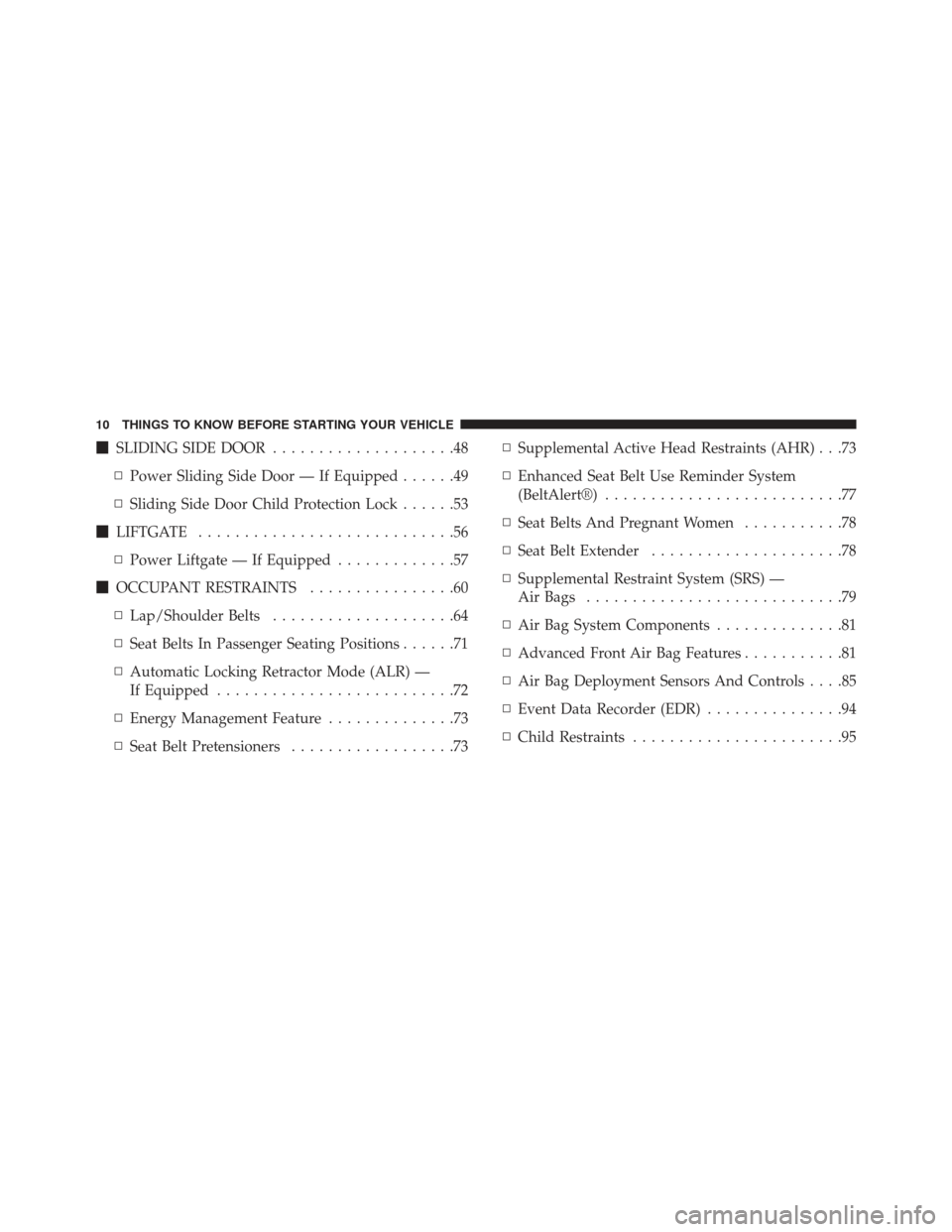
�SLIDING SIDE DOOR ....................48
▫ Power Sliding Side Door — If Equipped ......49
▫ Sliding Side Door Child Protection Lock ......53
� LIFTGATE ............................56
▫ Power Liftgate — If Equipped .............57
� OCCUPANT RESTRAINTS ................60
▫ Lap/Shoulder Belts ....................64
▫ Seat Belts In Passenger Seating Positions ......71
▫ Automatic Locking Retractor Mode (ALR) —
If Equipped ..........................72
▫ Energy Management Feature ..............73
▫ Seat Belt Pretensioners ..................73 ▫
Supplemental Active Head Restraints (AHR) . . .73
▫ Enhanced Seat Belt Use Reminder System
(BeltAlert®) ..........................77
▫ Seat Belts And Pregnant Women ...........78
▫ Seat Belt Extender .....................78
▫ Supplemental Restraint System (SRS) —
Air Bags ............................79
▫ Air Bag System Components ..............81
▫ Advanced Front Air Bag Features ...........81
▫ Air Bag Deployment Sensors And Controls ....85
▫ Event Data Recorder (EDR) ...............94
▫ Child Restraints .......................95
10 THINGS TO KNOW BEFORE STARTING YOUR VEHICLE
Page 36 of 699
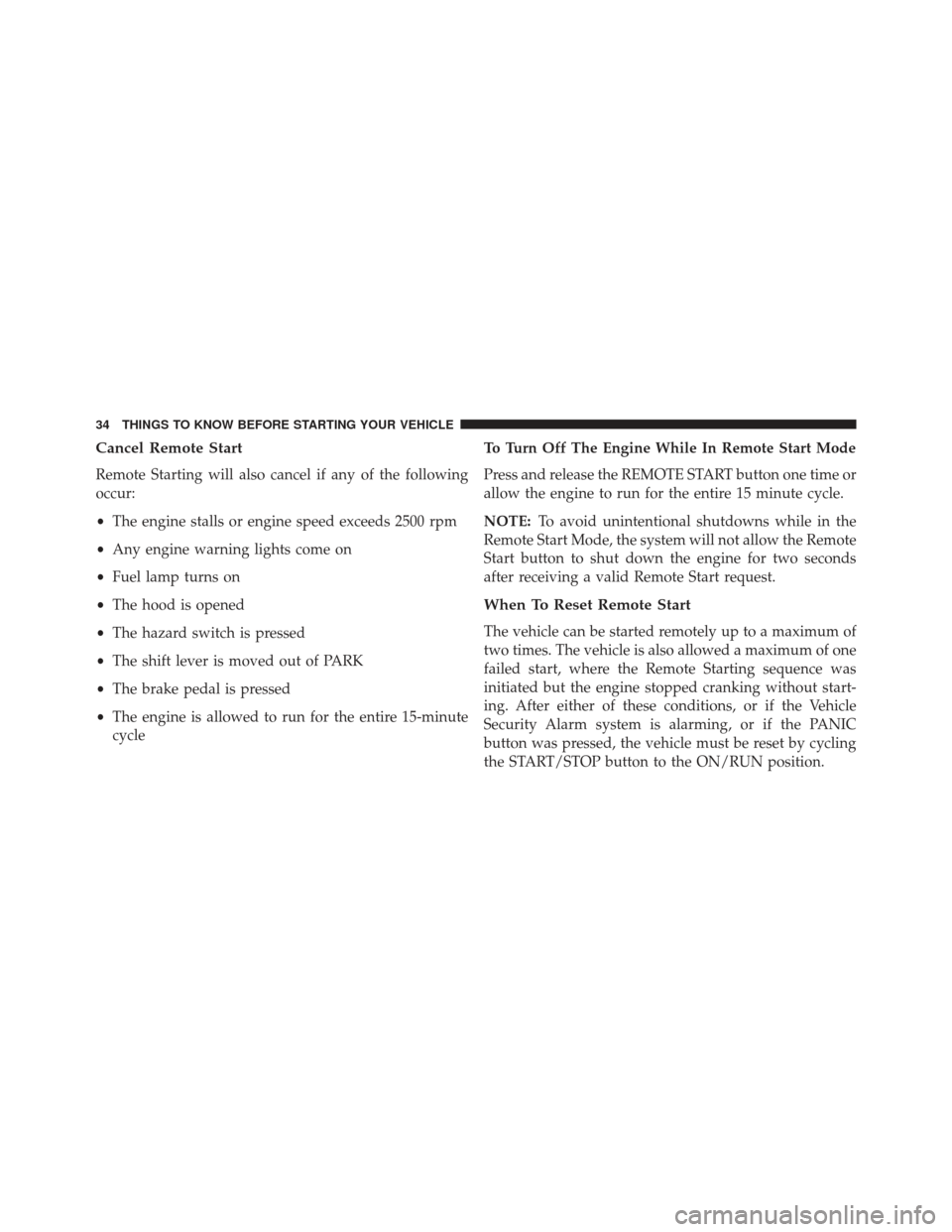
Cancel Remote Start
Remote Starting will also cancel if any of the following
occur:
•The engine stalls or engine speed exceeds 2500 rpm
• Any engine warning lights come on
• Fuel lamp turns on
• The hood is opened
• The hazard switch is pressed
• The shift lever is moved out of PARK
• The brake pedal is pressed
• The engine is allowed to run for the entire 15-minute
cycle
To Turn Off The Engine While In Remote Start Mode
Press and release the REMOTE START button one time or
allow the engine to run for the entire 15 minute cycle.
NOTE: To avoid unintentional shutdowns while in the
Remote Start Mode, the system will not allow the Remote
Start button to shut down the engine for two seconds
after receiving a valid Remote Start request.
When To Reset Remote Start
The vehicle can be started remotely up to a maximum of
two times. The vehicle is also allowed a maximum of one
failed start, where the Remote Starting sequence was
initiated but the engine stopped cranking without start-
ing. After either of these conditions, or if the Vehicle
Security Alarm system is alarming, or if the PANIC
button was pressed, the vehicle must be reset by cycling
the START/STOP button to the ON/RUN position.
34 THINGS TO KNOW BEFORE STARTING YOUR VEHICLE
Page 52 of 699
Press the button on the RKE transmitter twice within
5 seconds to open a power sliding door. When the door is
fully open, pressing the button twice within 5 seconds a
second time will close the door.
There are power sliding side door switches located on the
b-pillar trim panel, just in front of the power sliding door
for the rear seat passengers and in the overhead console
for the driver and passengers. Pressing the switch once
will open the power sliding door. If the switch is pressed
while the door is under a power cycle, the door will
reverse direction.
NOTE:The power sliding side door must be unlocked
before the power sliding door switches will operate. If the inside or outside door handles are used while the
power sliding side door is activated, the power sliding
door feature will be canceled and will go into manual
mode.
Power Sliding Door Switch
50 THINGS TO KNOW BEFORE STARTING YOUR VEHICLE
Page 62 of 699
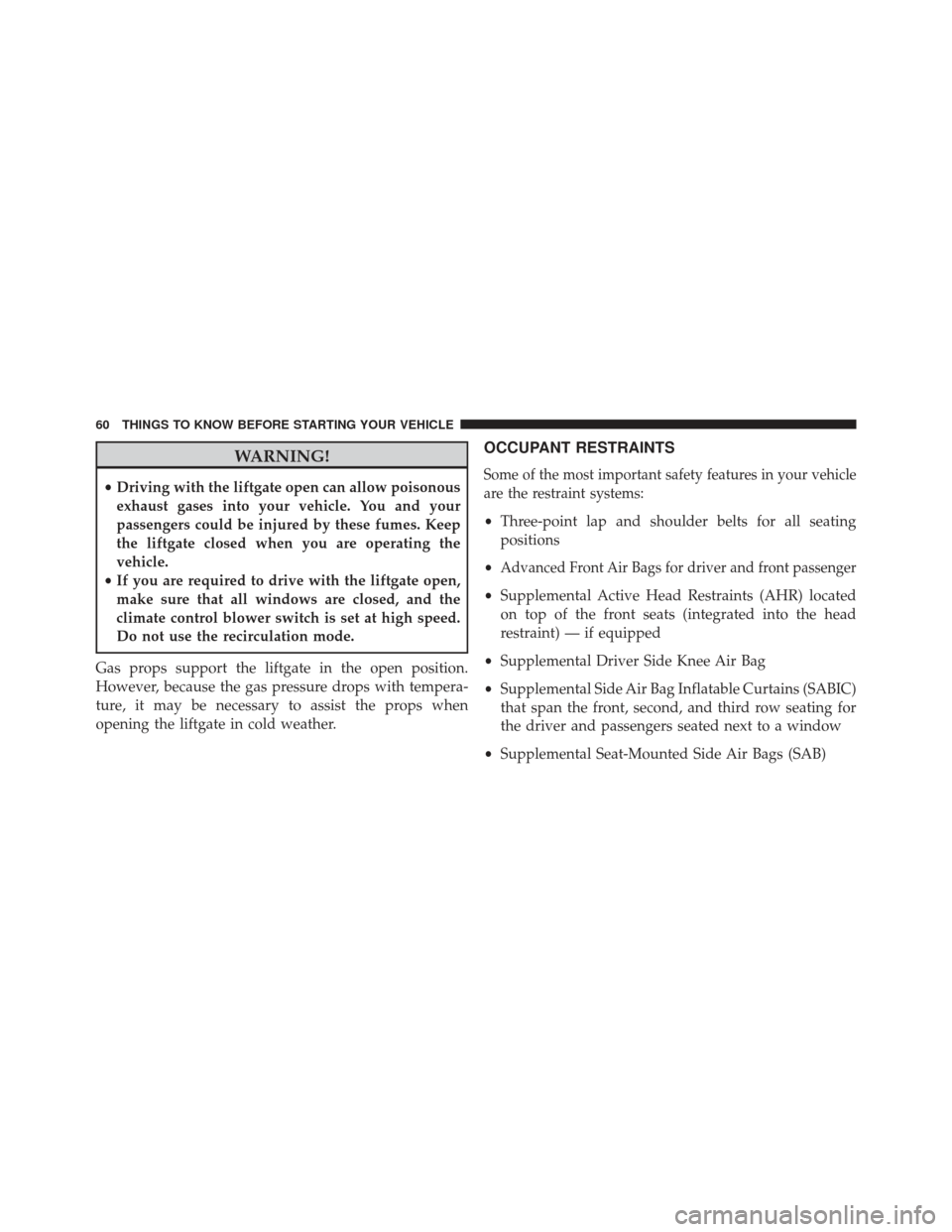
WARNING!
•Driving with the liftgate open can allow poisonous
exhaust gases into your vehicle. You and your
passengers could be injured by these fumes. Keep
the liftgate closed when you are operating the
vehicle.
• If you are required to drive with the liftgate open,
make sure that all windows are closed, and the
climate control blower switch is set at high speed.
Do not use the recirculation mode.
Gas props support the liftgate in the open position.
However, because the gas pressure drops with tempera-
ture, it may be necessary to assist the props when
opening the liftgate in cold weather.
OCCUPANT RESTRAINTS
Some of the most important safety features in your vehicle
are the restraint systems:
• Three-point lap and shoulder belts for all seating
positions
•
Advanced Front Air Bags for driver and front passenger
• Supplemental Active Head Restraints (AHR) located
on top of the front seats (integrated into the head
restraint) — if equipped
• Supplemental Driver Side Knee Air Bag
• Supplemental Side Air Bag Inflatable Curtains (SABIC)
that span the front, second, and third row seating for
the driver and passengers seated next to a window
• Supplemental Seat-Mounted Side Air Bags (SAB)
60 THINGS TO KNOW BEFORE STARTING YOUR VEHICLE
Page 114 of 699
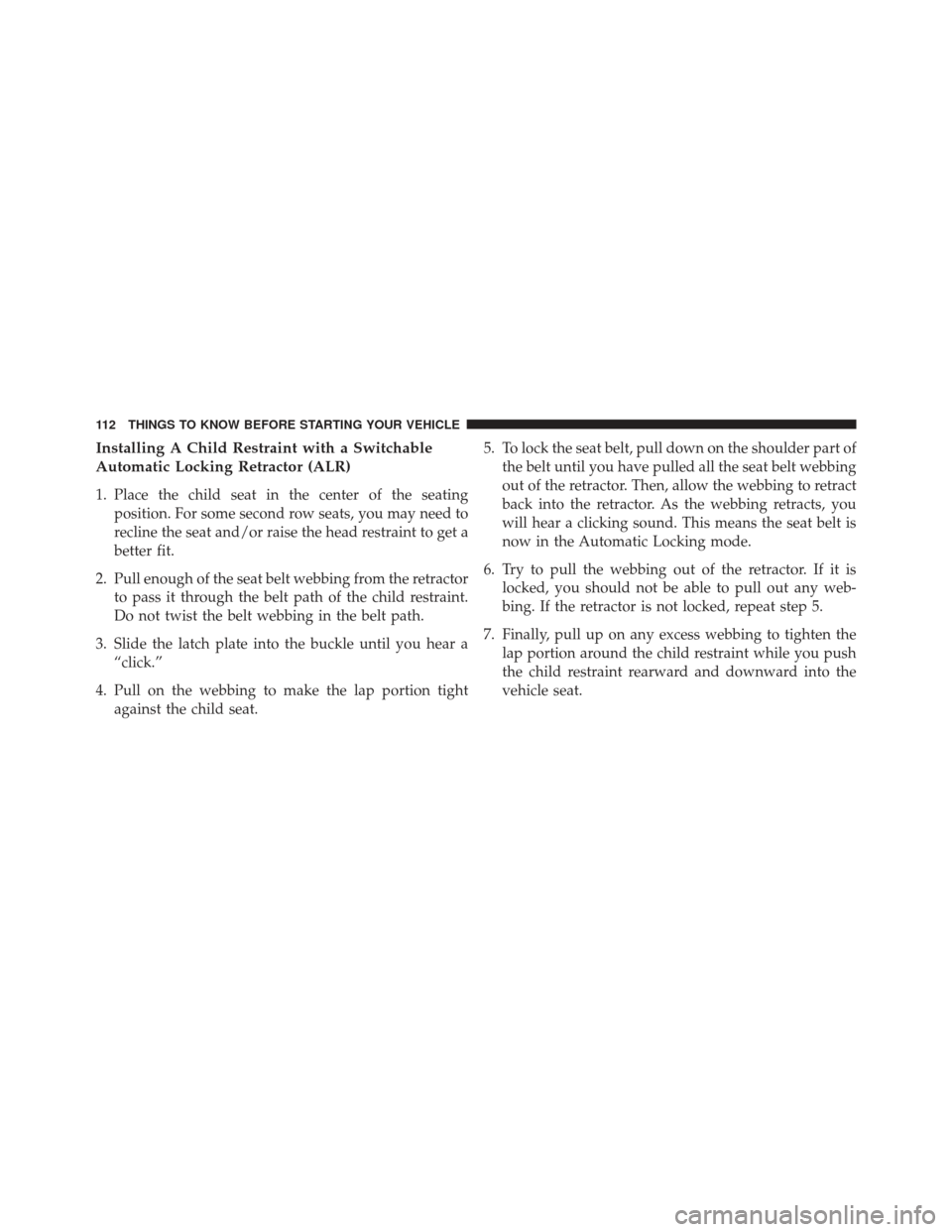
Installing A Child Restraint with a Switchable
Automatic Locking Retractor (ALR)
1. Place the child seat in the center of the seatingposition. For some second row seats, you may need to
recline the seat and/or raise the head restraint to get a
better fit.
2. Pull enough of the seat belt webbing from the retractor to pass it through the belt path of the child restraint.
Do not twist the belt webbing in the belt path.
3. Slide the latch plate into the buckle until you hear a “click.”
4. Pull on the webbing to make the lap portion tight against the child seat. 5. To lock the seat belt, pull down on the shoulder part of
the belt until you have pulled all the seat belt webbing
out of the retractor. Then, allow the webbing to retract
back into the retractor. As the webbing retracts, you
will hear a clicking sound. This means the seat belt is
now in the Automatic Locking mode.
6. Try to pull the webbing out of the retractor. If it is locked, you should not be able to pull out any web-
bing. If the retractor is not locked, repeat step 5.
7. Finally, pull up on any excess webbing to tighten the lap portion around the child restraint while you push
the child restraint rearward and downward into the
vehicle seat.
112 THINGS TO KNOW BEFORE STARTING YOUR VEHICLE
Page 122 of 699
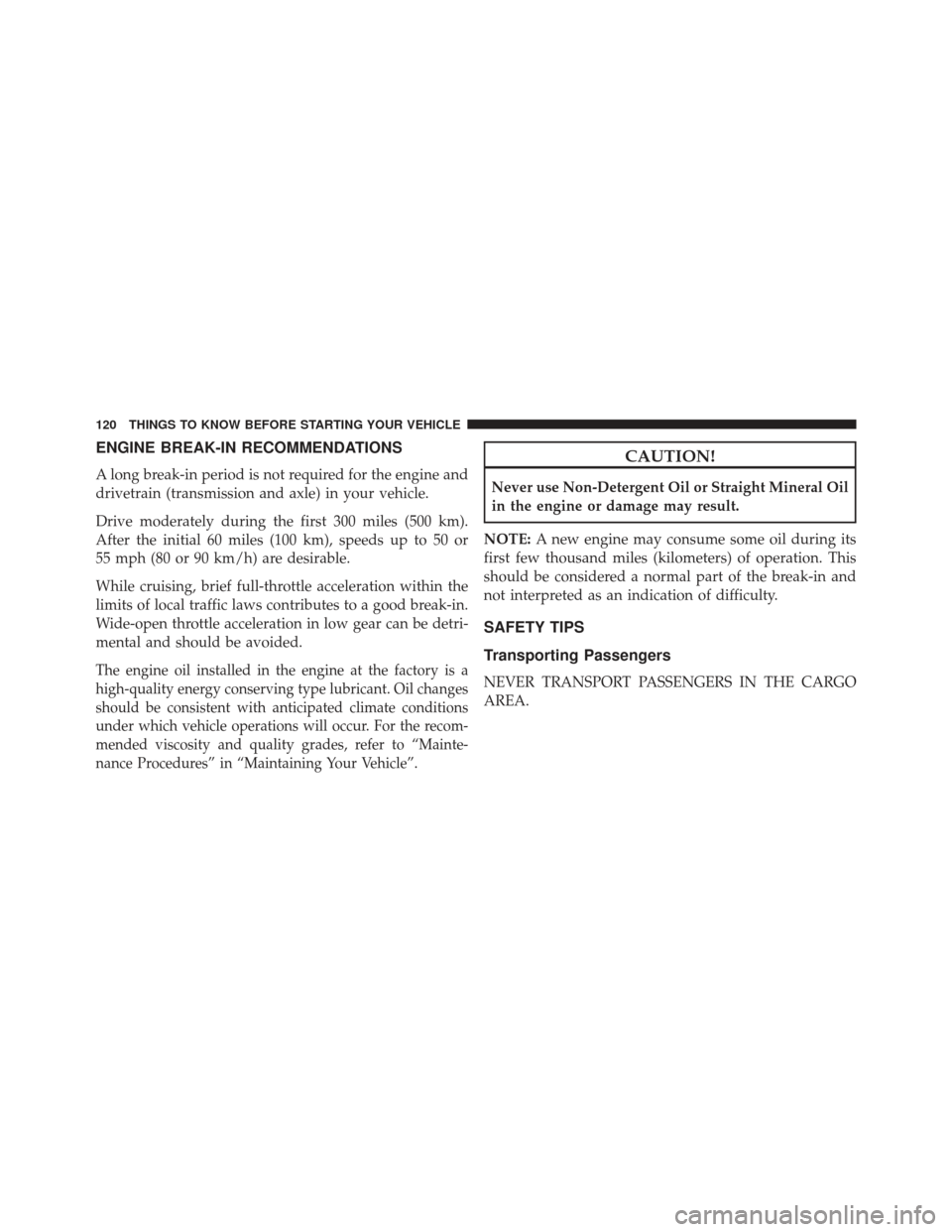
ENGINE BREAK-IN RECOMMENDATIONS
A long break-in period is not required for the engine and
drivetrain (transmission and axle) in your vehicle.
Drive moderately during the first 300 miles (500 km).
After the initial 60 miles (100 km), speeds up to 50 or
55 mph (80 or 90 km/h) are desirable.
While cruising, brief full-throttle acceleration within the
limits of local traffic laws contributes to a good break-in.
Wide-open throttle acceleration in low gear can be detri-
mental and should be avoided.
The engine oil installed in the engine at the factory is a
high-quality energy conserving type lubricant. Oil changes
should be consistent with anticipated climate conditions
under which vehicle operations will occur. For the recom-
mended viscosity and quality grades, refer to “Mainte-
nance Procedures” in “Maintaining Your Vehicle”.
CAUTION!
Never use Non-Detergent Oil or Straight Mineral Oil
in the engine or damage may result.
NOTE: A new engine may consume some oil during its
first few thousand miles (kilometers) of operation. This
should be considered a normal part of the break-in and
not interpreted as an indication of difficulty.
SAFETY TIPS
Transporting Passengers
NEVER TRANSPORT PASSENGERS IN THE CARGO
AREA.
120 THINGS TO KNOW BEFORE STARTING YOUR VEHICLE
Page 125 of 699
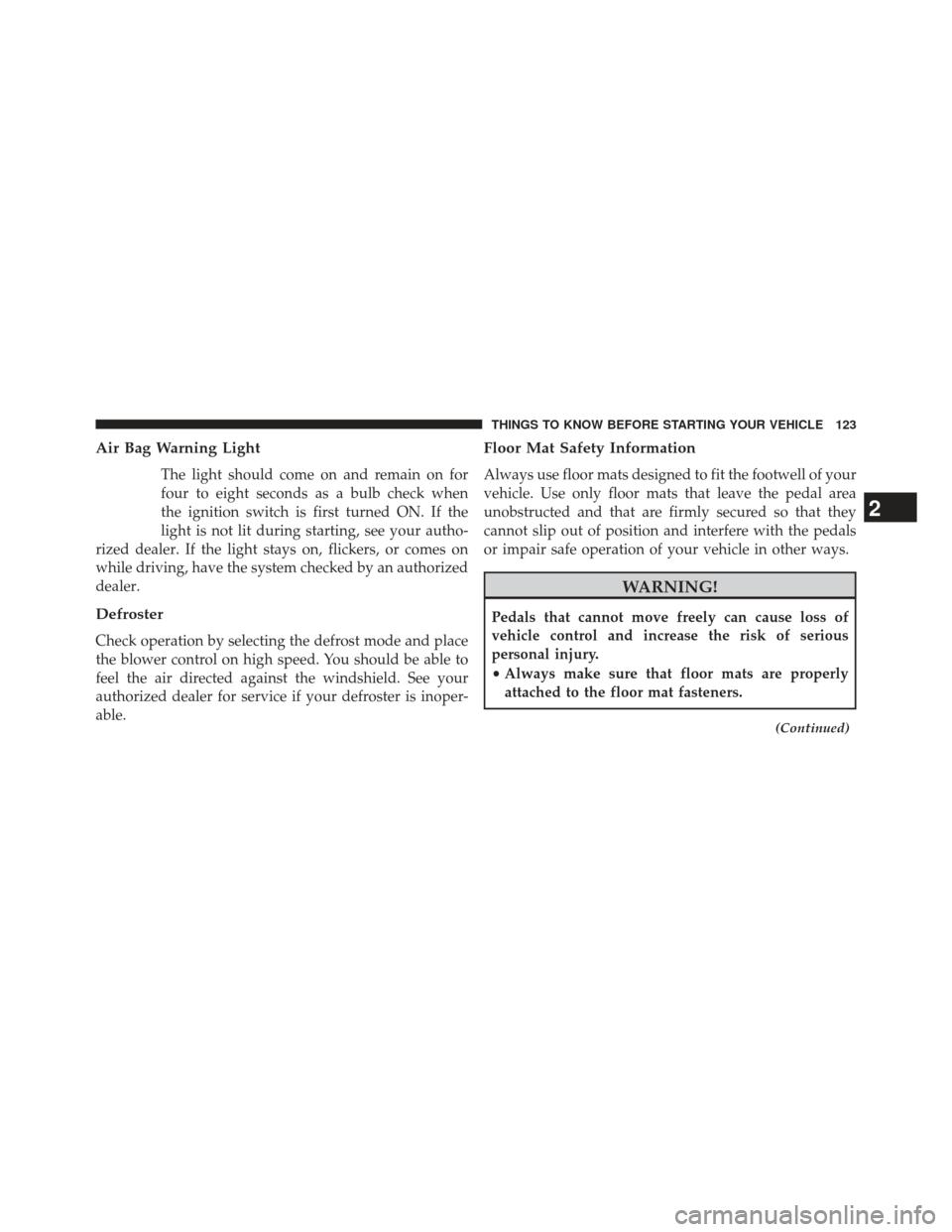
Air Bag Warning Light
The light should come on and remain on for
four to eight seconds as a bulb check when
the ignition switch is first turned ON. If the
light is not lit during starting, see your autho-
rized dealer. If the light stays on, flickers, or comes on
while driving, have the system checked by an authorized
dealer.
Defroster
Check operation by selecting the defrost mode and place
the blower control on high speed. You should be able to
feel the air directed against the windshield. See your
authorized dealer for service if your defroster is inoper-
able.
Floor Mat Safety Information
Always use floor mats designed to fit the footwell of your
vehicle. Use only floor mats that leave the pedal area
unobstructed and that are firmly secured so that they
cannot slip out of position and interfere with the pedals
or impair safe operation of your vehicle in other ways.
WARNING!
Pedals that cannot move freely can cause loss of
vehicle control and increase the risk of serious
personal injury.
• Always make sure that floor mats are properly
attached to the floor mat fasteners.
(Continued)
2
THINGS TO KNOW BEFORE STARTING YOUR VEHICLE 123
Page 150 of 699
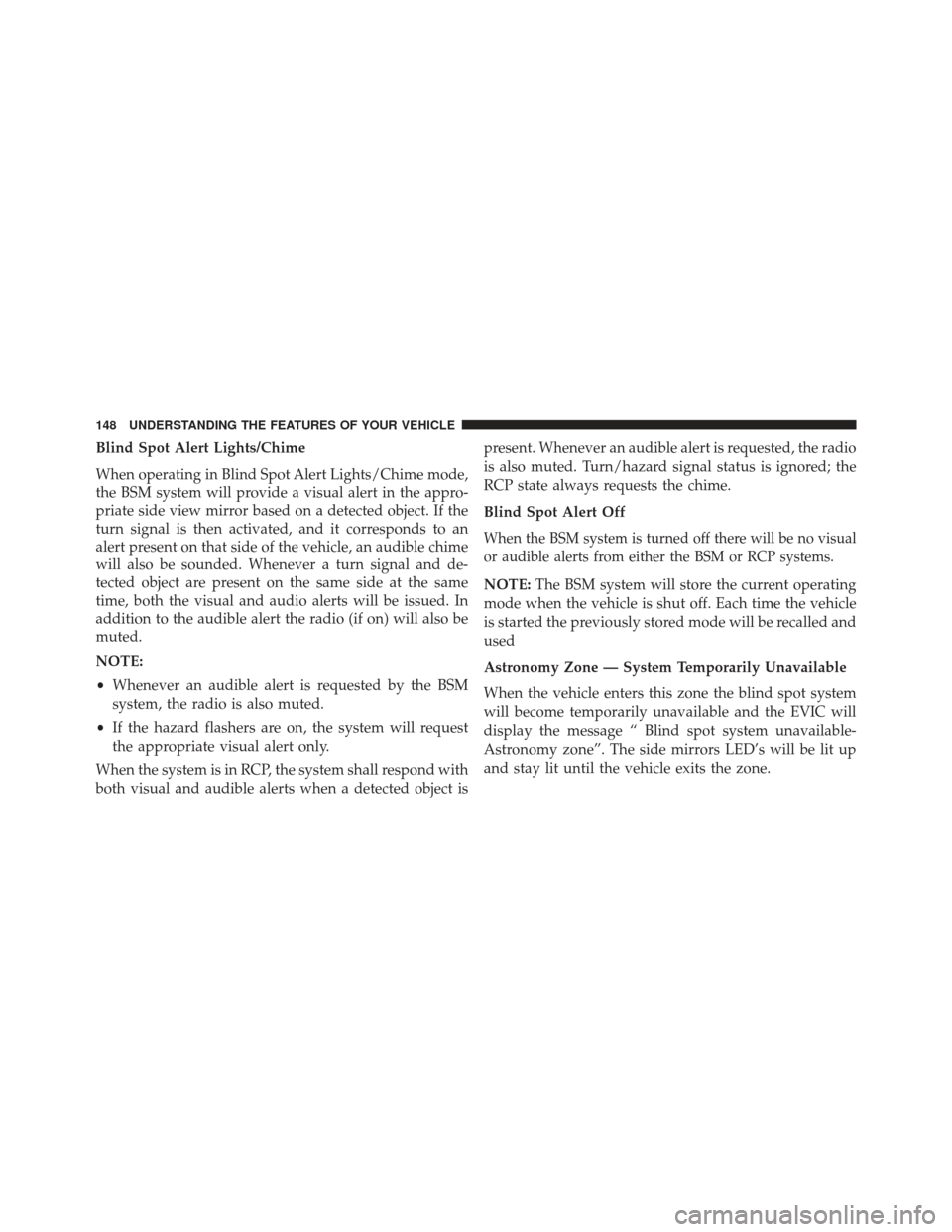
Blind Spot Alert Lights/Chime
When operating in Blind Spot Alert Lights/Chime mode,
the BSM system will provide a visual alert in the appro-
priate side view mirror based on a detected object. If the
turn signal is then activated, and it corresponds to an
alert present on that side of the vehicle, an audible chime
will also be sounded. Whenever a turn signal and de-
tected object are present on the same side at the same
time, both the visual and audio alerts will be issued. In
addition to the audible alert the radio (if on) will also be
muted.
NOTE:
•Whenever an audible alert is requested by the BSM
system, the radio is also muted.
• If the hazard flashers are on, the system will request
the appropriate visual alert only.
When the system is in RCP, the system shall respond with
both visual and audible alerts when a detected object is present. Whenever an audible alert is requested, the radio
is also muted. Turn/hazard signal status is ignored; the
RCP state always requests the chime.
Blind Spot Alert Off
When the BSM system is turned off there will be no visual
or audible alerts from either the BSM or RCP systems.
NOTE:
The BSM system will store the current operating
mode when the vehicle is shut off. Each time the vehicle
is started the previously stored mode will be recalled and
used
Astronomy Zone — System Temporarily Unavailable
When the vehicle enters this zone the blind spot system
will become temporarily unavailable and the EVIC will
display the message “ Blind spot system unavailable-
Astronomy zone”. The side mirrors LED’s will be lit up
and stay lit until the vehicle exits the zone.
148 UNDERSTANDING THE FEATURES OF YOUR VEHICLE